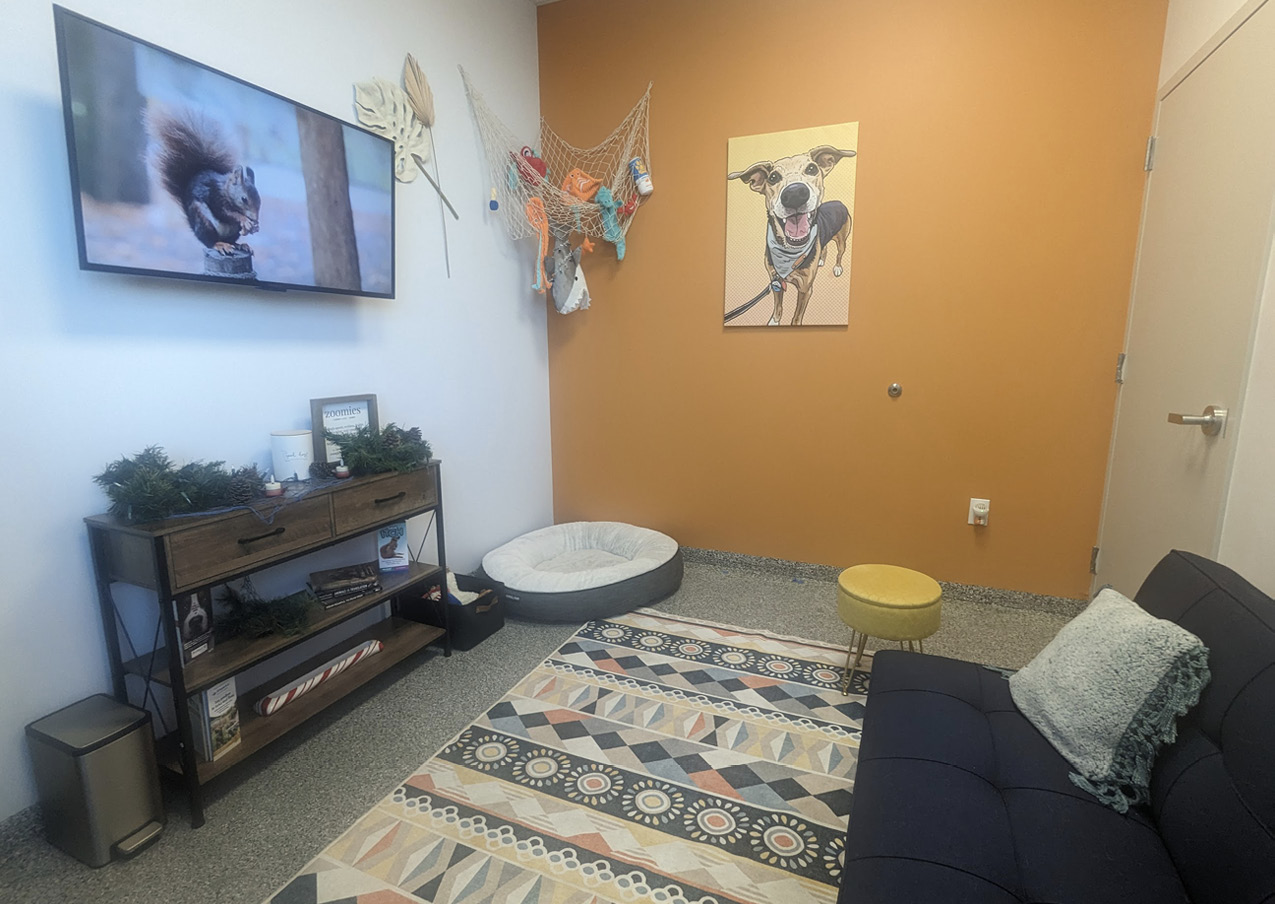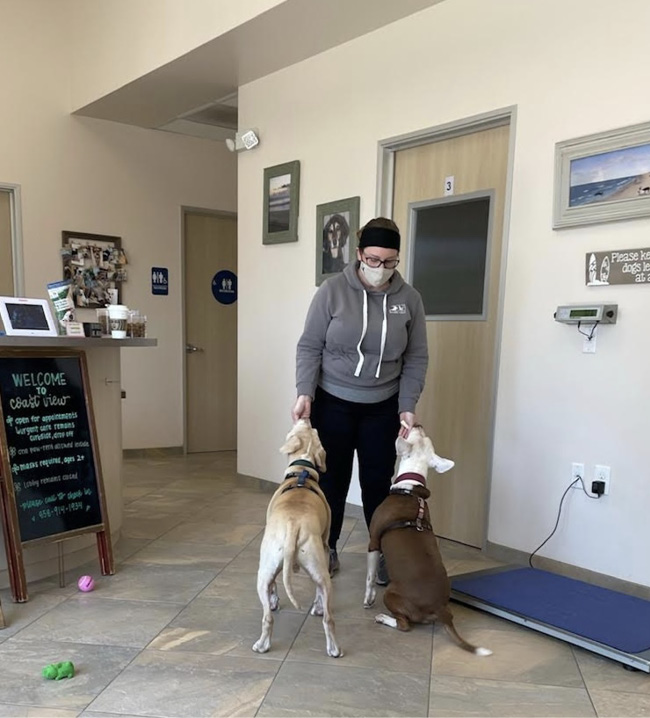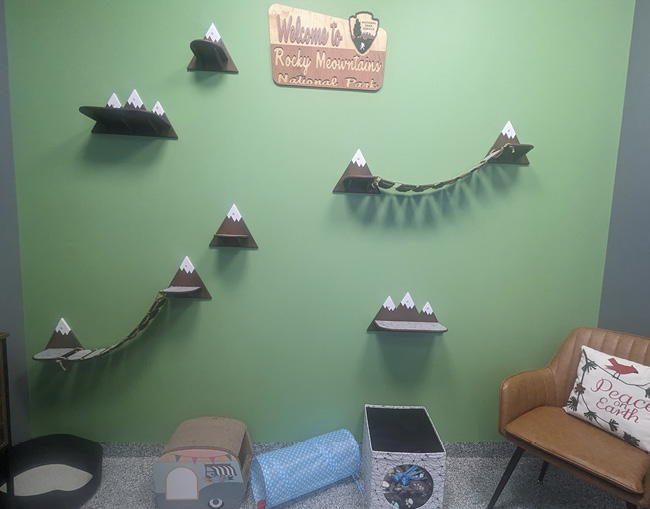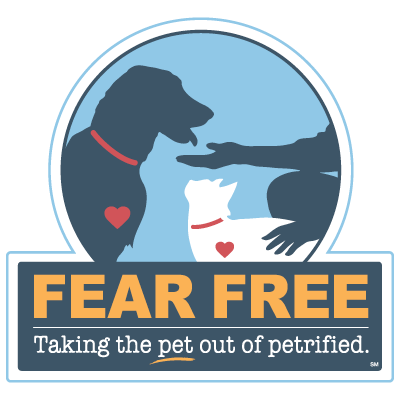A Look Inside Fear-Free Practices
The Movement That’s Revolutionizing Veterinary Medicine
By Lavanya Sunkara
 Dog exam room at PetVet365 in Westminster, Colorado.
Dog exam room at PetVet365 in Westminster, Colorado.
By now you must have heard the phrase Fear Free or heard of Fear Free-certified practices. But what exactly is Fear Free and what does it look like in practice?
Fear Free was founded by Marty Becker, DVM, in 2016, and was developed with the help of hundreds of experts in medicine, behavior, and handling. Since then, more than 320,000 veterinary and pet professionals, animal welfare communities, and pet owners have registered for Fear Free’s programs and courses. According to Becker, the majority of all veterinary schools now also incorporate Fear Free into their curriculum.
One of the basic tenets of Fear Free is that people—including veterinary staff—are unintentionally scaring animals every single day in the ways they interact with them, says Tori Williams, chief operating officer of Fear Free. For example, in many practices’ exam rooms, the pet is restrained for the exam and then “taken to the back” if vaccines or tests are needed. All of this can be extremely stressful, leading to barking, hissing, and even biting out of fear.
Even the act of lifting the patient onto the exam table is questioned in Fear Free’s teachings.
 Beau and Mama Julep at CoastView Veterinary Hospital, San Diego, Calif., with Leanne Beth Schmitt, RVT.
Beau and Mama Julep at CoastView Veterinary Hospital, San Diego, Calif., with Leanne Beth Schmitt, RVT.
“The number one fear from birth for all animals is the fear of falling,” said Becker. Yet, the first thing that happens in many exam rooms is that the pet is lifted up and put on a cold, slippery stainless steel table.
“We are basically making them face one of their inherent fears of being in a high place,” says Sarah Hilliard, DVM, co-owner of PetVet365, a Fear-Free–certified practice in Westminster, Colorado, where exam rooms have couches and rugs instead of high metal tables.
The international movement’s objective is to prevent and alleviate fear, anxiety, and stress (FAS) not only in pets, but also for the people who care for them. With Fear Free protocols in place, Becker says, pets not only are less fearful, they can even enjoy the experience of going to the vet.
“In Fear Free, the dog drags them in there, and they have to try to drag them out because we put the ‘treat’ in the treatment,” Becker says. “What you’re doing is so incredible that you won’t have to see the trauma.”
How Fear Free Differs from Traditional Veterinary Practice
Before pet owner AJ Albrecht found a Fear Free clinic, she was shocked to witness at her old veterinarian’s office the forceful manner in which one of her fearful rescue dogs was dragged into the back on a slip lead with his tail between his legs.
So she was delighted when she found CoastView Veterinary Hospital, a Fear-Free–certified hospital in San Diego that offered “happy visits.”
At a Fear Free practice, the pet’s triggers and inherent fears are assuaged by a safe environment and the use of positive reinforcement. In some cases, veterinarians recommend a “Chill Protocol” of pharmaceuticals for severely anxious pets. The animal is allowed a chance to adjust and interact with toys, treats, and other enrichment activities.
“The lobby floor was covered in toys, and Leanne Beth Schmitt, a vet tech who is also a Karen Pryor–certified trainer, greeted our dogs with lots of treats,” she recalled. The goal of the visit was for her mixed-breed rescue dogs, Beau and Mama Julep, to simply enjoy the space without being handled. “Seeing them both zoom around, sniffing and playing and having fun with Leanne, was a stark contrast to our early vet experiences.”
Fear Free operates from the core principle that animals are sentient beings with emotions, and it’s vital for those who care for them—from groomers and trainers to veterinarians and technicians—to not do anything that makes them afraid. This results in a more positive experience for everyone involved—and a more accurate diagnosis.
One of the biggest advantages of Fear Free is that there’s a chance to better diagnose health issues when the animal is not experiencing FAS. An animal’s fight-or-flight response causes a spike in adrenaline that leads to changes in physiology. “A horse limps on the ranch. You take it to the vet, and it does not limp because it’s a prey animal and it’s in fight-or-flight mode,” said Becker. The same principle applies to cats and dogs.
Simply being up on the exam table can elevate the pet’s vitals. “If the pet is calm and happier and has an increased temperature, maybe it’s an infection, not just artificial shivering because he is stressed out,” Becker said.
Fundamentals of Fear Free
Creating a Peaceful and Enriching Environment
Upon entering PetVet365’s Westminster location, it’s immediately clear why furry friends and their owners love it. The newly built facility, opened in late 2023, incorporates Fear Free throughout, with two separate sections for dogs and cats.
PetVet365 is the country’s first and only network of veterinarians with an entirely Fear Free-certified staff, with hospitals designed to provide a peaceful experience. “We are very intentional about not mixing cats and dogs,” said Maggie Lind, RVT.
The facility doesn’t have a traditional lobby; locked doors control the traffic, so animals don’t run into one another and cause unnecessary stress. The cat rooms are filled with comforts, from feline-specific pheromones and catnip to areas where they can scratch, hide, and climb (onto the Rocky Meowntains wall mounts) and enrichment via cat TV. Dog exam rooms have a couch with pillows, rug, toys, and beds. Patients are treated to yummy treats, which can be preordered if a pet prefers a certain flavor.
More importantly, the pet owner never leaves the side of their pet.
“We do all the examinations in front of the pet parent, so they see that their pet is much more relaxed, and that encourages them to continue doing that every time they bring them in,” said Iheoma Ehie, DVM, who co-owns a PetVet365 practice in Atlanta. She often sits on the carpet or the couch when conducting an exam.
“That has made a world of a difference, because even some pet owners have looked up clinics based on Fear Free status.” For those who can’t completely transform their exam rooms or have a Fear Free facility built from scratch like PetVet365, Ehie recommends keeping the steel table lifted up and adding a rug.
Because animals can’t give verbal consent, staff can get it by reading their body language and behaviors.
Giving Animals Agency
At the root of Fear Free is not forcing animals to do anything against their will. Hilliard recalls her pre–Fear Free experience, how the patients went straight into the exam room where a technician would restrain the pet (sometimes tightly, if wiggling), so she could perform the exam.
“It’s obvious to me now, but when I was doing it [before Fear Free], we had to get things done,” she said. “We were not going to necessarily ask for permission.”
When animals are brought to the practice, they have no idea why they are there, says Becker. It’s especially hard if they’ve had negative experiences in the past. “They have zero idea why a procedure benefits them. They also have no concept of time,” he added. “Lastly, they can’t flee the threat.”
Because animals can’t give verbal consent, staff can get it by reading their body language and behaviors. This way, “we can better understand whether they’re saying ‘yes, go ahead and do this' or, 'no, I am about to have a panic attack, please, please, please don’t do this to me’,” says Hilliard. “What we are essentially doing is asking a nonverbal being for consent before we do something.”
Pet owner and Fear Free-certified dog trainer Erica Beckwith in Santa Fe, New Mexico, says traditional vet care with restraint was terribly scary for her dogs. Her 12-year-old cocker spaniel/Jindo mix named Myles would vocalize loudly when restrained before any shots.
“I started asking to have him sedated for even nail trims, but, at traditional vets, many of them downplayed his fear.” She remembers leaving one clinic in tears with a scared and traumatized dog. She has since switched to a Fear Free practice and is now transitioning to a mobile Fear Free veterinarian.
At Hilliard’s new practice, the staff keeps records of each pet’s physical and emotional well-being, the latter focusing on the patient’s triggers and what tactics worked to reduce stress and make them comfortable, so they are better prepared for future visits.
Gentle Handling and Positive Reinforcement
Once the animal is calm and adjusted, gentle handling helps the veterinarian or technician get desired results. “We will start touching them at the least reactive part of their body,” says Lind. “If we need to examine their paw, we might touch their shoulder first and work our hands down their leg, which is a lot more comfortable for a pet and less shocking than having their paw being grabbed right off the bat.”
Additionally, assent is achieved through positive reinforcement. “When the animal gets rewarding treats, they won’t even see the nail trimmers,” said Becker. Recently at Hilliard’s clinic, the staff were able to draw blood from a feline patient’s neck while the owner fed them a yummy tube of chicken paste.
One of the benefits of being a Fear Free practice is that pharmaceuticals are used much more readily than in traditional practices to help calm the animal down./p>
At CoastView Veterinary Hospital, Albrecht worked with the vet tech to adopt a consent-based behavior modification program for her dog, Mama Julep, so she can “opt in” to the blood draw. “She sits on a mat and when we count to three, she is pricked and the blood is drawn. She gets lots of high value food rewards,” Albrecht said. Of course, if Mama Julep resists or avoids, they call it off for the day.
There is a misconception that restraint is never used in Fear Free. This hard line is not necessarily true, says Williams. “With Fear Free, we refer to our restraint techniques as gentle control and stabilization. We are going to show you the steps you can take before you just put a muzzle on a dog but, of course, we have to keep our people, the animals, and pet parents safe.” In a Fear Free setting, the staff may use an Elizabethan collar, towel wrap, or a basket muzzle (to allow for the pet to still eat treats), while monitoring the pet’s FAS level and offering positive reinforcement throughout the experience.
Opting for the Chill Protocol
Despite taking all the right steps, some pets that have experienced trauma may need anti-anxiety medication for any activities that incites trepidation—even for basic tasks like nail trims. With the right combination of medications, Becker says, “they can have the same experience as everybody else, courtesy of nutraceuticals or pharmaceuticals.”
One of the benefits of being a Fear Free practice is that pharmaceuticals (both oral and injectables) are used much more readily than in traditional practices to help calm the animal down. In some cases, medication, such as Gabapentin, is preprescribed for the fearful feline or canine to take the night before and one to two hours before the appointment. “The first time Myles went to the vet with gabapentin on board, he waggily approached the vet and the tech to sniff and say hi for the first time in years,” recalled Beckwith.
“If we need to examine their paw, we might touch their shoulder first and work our hands down their leg, which is a lot more comfortable for a pet and less shocking than having their paw being grabbed right off the bat.”
Maggie Lind, RVT
If the medication doesn’t work out for that day, and the treatment can wait, the appointment is postponed and the client is sent home with a different medication protocol. “If it’s something that we have to take care of today, then we’ll just completely sedate them. Everybody’s safe, and everything still gets done the way it needs to get done,” stated Ehie.
 Cat Exam Room at PetVet365 in Westminster, Colorado.
Cat Exam Room at PetVet365 in Westminster, Colorado.
Veterinary assistant Sharm Tasmin of Riverside Veterinary Care on Columbus, a Fear Free-certified hospital in New York City, says that her own cats need to be sedated for vet visits. She shares this information with pet owners who might be apprehensive about using medication. “It’s totally fine to have them sedated and they’re happier because they don’t have to remember that we were doing their treatments,” Tasmin said. Sedation also helps keep the animal and staff safe, if the patient is showing aversion or aggression.
The usage of medication in a Fear Free setting is something Tasmin finds extremely helpful. Being a part of a Fear Free hospital gives her the confidence to let a pet owner with an especially anxious animal know that she does not feel comfortable doing a nail trim (or anything else) without medication. She can request that they return when the animal is medicated, instead of trying multiple times on a stressed-out animal. “It’s just so much easier to do my job,” she said.
Fostering a Stress-Free Work Environment for Staff
Hilliard graduated from veterinary school 15 years ago with aspirations of being a specialist, but a serious mental health crisis related to her work made her leave residency and begin working in general practice. She practiced for six years before leaving for a nonclinical job.
“The wear and tear on me emotionally led me to a point where I had to leave practice all together,” Hilliard said. It was Fear Free that brought her back to veterinary practice as the co-owner of PetVet365. “I have been through my own trauma, and I want to make the profession better,” said Hilliard. She especially likes that she can provide better care for her patients, herself, and her staff.
“I really had a lot more bruises on my body before [Fear Free], just physical stress to my body throughout the day. It’s a lot different now,” says Lind, who works with Hilliard. She says veterinary technicians often compromise their own bodies, laying on the ground holding down dogs who are filled with fear. Now, she doesn’t have to.

By the Numbers
According to the Fear Free website, the cost of membership for Fear Free certification ranges from $775 per year for a practice with one full-time equivalent (FTE) veterinarian on staff, up to $2,800 per year for six or more FTE veterinarians.
Practices must also complete a re-certification process every three years. Check out fearfreepets.com for more information.
The Business Case for Going Fear Free
Becoming Fear-Free certified is seamless and the results are incredibly positive, according to many who have gone through the process. The courses are self-paced with quizzes at the end, and it typically takes around eight hours. Certified professionals renew annually to ensure access to continuing education and other benefits. For practice certification, a hospital needs to showcase that their standard operating procedures align with Fear Free requirements, both in writing as well as a virtual interview, explained Williams.
Once certified, practicing in a Fear Free way is a skill that must be learned and practiced, she adds. “The more you practice it, the quicker it will be utilized within unique scenarios.” This means while appointments for new patients might be longer at first, they don’t have to stay long once there’s a Fear Free plan in place.
Embracing Fear Free can also unlock growth. According to a 2021 Fear Free white paper, Fear Free clinics noticed a 14% increase in patients and a 23% increase in revenue per practice. They also saw a 44% increase in forward bookings for canine patients and a 37% increase in feline patients after three years. More importantly, there is a significant reduction in injuries.
Anyone who chooses the veterinary industry loves animals and wants them to return the love. It’s not fun going to work where a defensive cat is hissing or a traumatized dog is cowering in the corner. Fear Free can address these situations, without compromising the safety and well-being of everyone, especially the animals who can’t speak for themselves. Today’s pet owners want to bring their beloved animals to a place where they are happy and excited.
“My previously vet-phobic dogs now station in a trained position willingly for blood draws, vaccines, full exams,” says Beckwith. Their blood work shows more accurate results because they are much more relaxed. More importantly, she is much more willing to go to the veterinarian knowing it won’t completely traumatize her dogs or her. “My dogs trust me so much, and they control the visit almost entirely.”
 |
Lavanya Sunkara is an award-winning writer who lives in the suburbs of New York City. She has been taking her two senior dogs to a holistic, Fear Free-certified veterinarian for years and hopes to spread awareness of the movement far and wide. |
Photo credits: Lavanya Sunkara, AJ Albrecht



